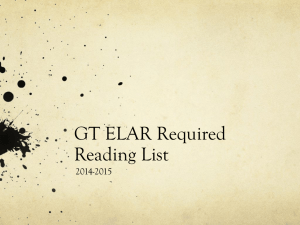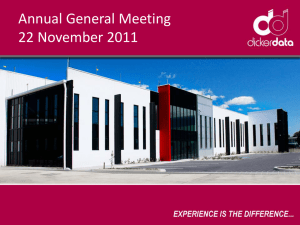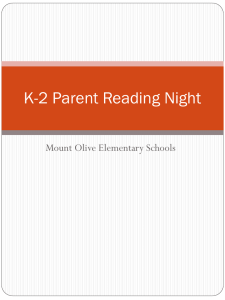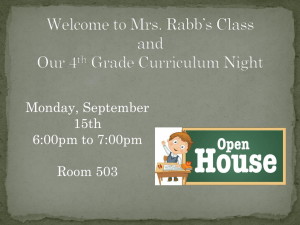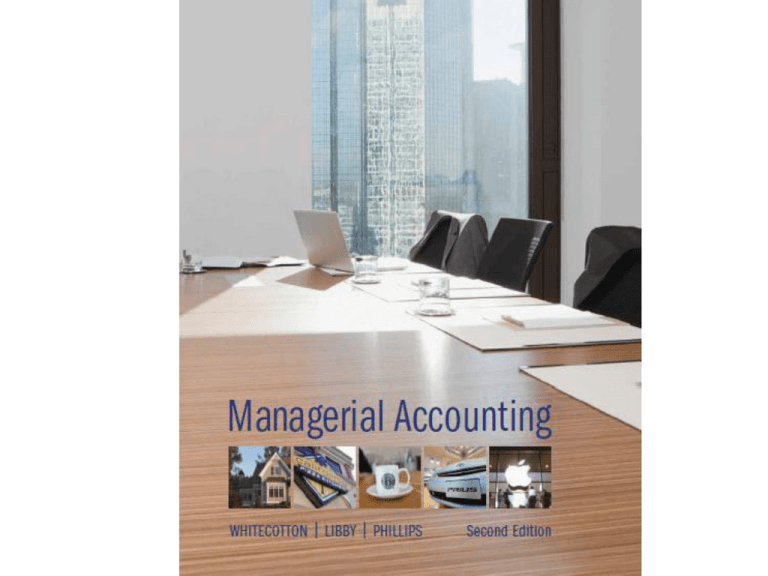
Chapter 8
Budgetary Planning
PowerPoint Authors:
Susan Coomer Galbreath, Ph.D., CPA
Charles W. Caldwell, D.B.A., CMA
Jon A. Booker, Ph.D., CPA, CIA
Cynthia J. Rooney, Ph.D., CPA
McGraw-Hill/Irwin
Copyright © 2014 by The McGraw-Hill Companies, Inc. All rights reserved.
Learning Objective 8-1
Describe (a) how and why
organizations use budgets for
planning and control and (b) potential
behavioral issues to consider when
implementing a budget.
8-3
Role of Budgets in the Planning and
Control Cycles
A budget is a comprehensive financial
plan for achieving the financial and
operational goals of an organization.
Planning
Developing
objectives for
acquisition
and use of
resources.
Control
Steps taken by
management to
ensure that
objectives are
attained.
8-4
Planning and Control Cycle
8-5
Planning Process
Strategic
Plan
Long-term
Objectives
Short-term
Objectives
Tactics
8-6
Benefits of Budgeting
Thinking Ahead
Communication
Motivation
Forcing managers to
look ahead and state
their goals for the future
Communicating
management's
expectations
and priorities
Providing motivation for
employees to work
toward organizational
objectives
Providing lead time to
solve potential problems
Promoting cooperation
and coordination
between functional
areas of the organization
Providing a benchmark
for evaluating
performance
8-7
Behavioral Effects of Budgets
Budget Problems
Solution
• Perceived unfair or
unrealistic goals.
• Reasonable and
attainable budgets.
• Poor managementemployee
communications.
• Employee participation in
budgeting process.
8-8
Behavioral Effects of Budgets
Budget Problems
• Building budget slack
into budgets.
• A “use-it-or-lose-it”
mentality.
Solution
• Different budgets for
planning and for
performance evaluation.
• Continuous, or rolling
budgets.
• Zero-based budgeting.
8-9
Learning Objective 8-2
Describe the major components of
the master budget and their
interrelationships.
8-10
Components of the Master Budget
8-11
Learning Objective 8-3
Prepare the following components of
the operating budget:
a.
b.
c.
d.
e.
f.
g.
h.
Sales budget.
Production budget.
Raw materials purchases budget.
Direct labor budget.
Manufacturing overhead budget.
Cost of goods sold budget.
Selling and administrative budget.
Budgeted income statement.
8-12
Preparation of the Operating Budgets
Let’s take a closer look at the operating budgets
using Cold Stone Creamery as our example.
8-13
Sales Budget
Sales
Budget
Estimated
Unit Sales
Estimated
Unit Price
Analysis of economic and market conditions
+
Forecasts of customer needs from marketing personnel
8-14
Sales Budget
We begin the preparation of operating budgets with
the sales budget using information from a single Cold
Stone Creamery location.
Budgeted Amounts Quarter 1
Quarter 2
Quarter 3
Quarter 4
Total
Sales (Units)
15,000
20,000
27,000
23,000
85,000
Unit Price
× $
5.00 × $
5.00 × $
5.00 × $
5.00 × $
5.00
Sales Revenue
$ 75,000
$ 100,000
$ 135,000
$ 115,000
$ 425,000
We prepare the sales budget by multiplying the number
of units we expect to sell times the budgeted unit price.
8-15
Production Budget
The production budget is directly related to the sales budget
and to the quantity of inventory the company wants to have on
hand at the beginning and end of each period. The
relationship between budgeted production, sales, and
inventory is summarized in the following formula:
8-16
Production Budget
Prepare a production budget for Cold Stone Creamery using the
sales budget and the following inventory policy: Cold Stone
maintains an ending inventory of finished goods equal to 5
percent of budgeted sales in units for the current period. The
beginning inventory for Quarter 1 (for the year) is 900 units.
8-17
Production Budget
5% of 15,000
5% of 20,000
5% of 27,000
5% of 23,000
Budgeted Amounts
Quarter 1
Quarter 2
Quarter 3
Quarter 4
Unit sales
15,000
20,000
27,000
23,000
Ending Inventory
+
750 +
1,000 +
1,350 +
1,150 +
Beginning Inventory –
900 –
750 –
1,000 –
1,350 –
Production
14,850
20,250
27,350
22,800
Total
85,000
1,150
900
85,250
8-18
Raw Materials Purchases Budget
Next, we must determine what quantity of raw materials to
purchase to use for the production budget. Budgeted material
purchases will depend on budgeted production needs, as well
as on the planned levels for beginning and ending raw
materials inventory. The relationship between budgeted raw
material purchases, budgeted production, and raw materials
inventory is summarized in the following formula:
8-19
Raw Materials Purchases Budget
Prepare a raw materials purchases budget for Cold Stone
Creamery using the production budget and the following inventory
policy: Cold Stone maintains an ending inventory of materials equal
to 3 percent of the next quarter’s production needs, making the
beginning inventory for each quarter equal to 3 percent of the
current quarter’s production needs. The ending inventory for
Quarter 4 (for the year) is assumed to be 3,510 ounces. Each Cold
Stone ice cream creation requires a total of 10 ounces of raw
materials (ice cream, candy, fruit, nuts, caramel, etc.) at an average
cost of $0.05 per ounce.
8-20
Raw Materials Purchases Budget
From Production Budget
Budgeted Amounts
Production (Units)
Material per Unit (Ozs.)
Total Material (Ozs.)
End. Inventory (Ozs.)
Beg. Inventory (Ozs.)
Total Purchases (Ozs.)
Cost per Ounce
Cost of Purchases
3% of 202,500
×
+
–
×
Quarter 1
14,850
10
148,500
6,075
4,455
150,120
$
0.05
$ 7,506
×
+
–
×
Quarter 2
20,250
10
202,500
8,205
6,075
204,630
$
0.05
$ 10,232
×
+
–
×
Quarter 3
27,350
10
273,500
6,840
8,205
272,135
$
0.05
$ 13,607
×
+
–
×
3% of 273,500
Quarter 4
22,800
10
228,000
3,510
6,840
224,670
$
0.05
$ 11,233
×
+
–
×
Total
85,250
10
852,500
3,510
4,455
851,555
$
0.05
$ 42,578
3% of 228,000
3% of 148,500
8-21
Raw Materials Purchases Budget
Budgeted Amounts
Production (Units)
Material per Unit (Ozs.)
Total Material (Ozs.)
End. Inventory (Ozs.)
Beg. Inventory (Ozs.)
Total Purchases (Ozs.)
Cost per Ounce
Cost of Purchases
×
+
–
×
Quarter 1
14,850
10
148,500
6,075
4,455
150,120
$
0.05
$ 7,506
×
+
–
×
Quarter 2
20,250
10
202,500
8,205
6,075
204,630
$
0.05
$ 10,232
×
+
–
×
Quarter 3
27,350
10
273,500
6,840
8,205
272,135
$
0.05
$ 13,607
×
+
–
×
Quarter 4
22,800
10
228,000
3,510
6,840
224,670
$
0.05
$ 11,233
×
+
–
×
Total
85,250
10
852,500
3,510
4,455
851,555
$
0.05
$ 42,578
8-22
Direct Labor Budget
Each Cold Stone Creamery creation requires 0.10 hour (6 minutes)
of direct labor (DL) time to take customers’ orders and payments, to
mix and serve the ice cream, and to clean up. The direct labor rate is
$10.00 per hour. Let’s prepare the direct labor budget.
Budgeted Amounts
Quarter 1
Quarter 2
Quarter 3
Quarter 4
Total
Production (Units)
14,850
20,250
27,350
22,800
85,250
DL Hours per Unit ×
0.10 ×
0.10 ×
0.10 ×
0.10 ×
0.10
Total DL Hours
1,485
2,025
2,735
2,280
8,525
DL Rate per Hour
× $ 10.00 × $
10.00 × $
10.00 × $
10.00 × $
10.00
Total DL Cost
$ 14,850
$ 20,250
$ 27,350
$ 22,800
$ 85,250
8-23
Manufacturing Overhead Cost Budget
Cold Stone Creamery’s variable manufacturing overhead cost is
$0.10 per unit and the fixed manufacturing overhead cost is $8,525
per quarter. Let’s prepare the manufacturing overhead budget.
Budgeted Amounts
Quarter 1
Quarter 2
Quarter 3
Quarter 4
Total
Production (Units)
14,850
20,250
27,350
22,800
85,250
Variable OH Rate
× $
0.10 × $
0.10 × $
0.10 × $
0.10 × $
0.10
Total Variable OH
$ 1,485
$
2,025
$
2,735
$
2,280
$
8,525
Fixed MOH
+
8,525 +
8,525 +
8,525 +
8,525 +
34,100
Total MOH
$ 10,010
$ 10,550
$ 11,260
$ 10,805
$ 42,625
8-24
Budgeted Cost of Goods Sold
First, let’s compute the manufacturing cost per unit, and
then we will compute cost of goods sold for each period.
Budgeted Amounts
Direct Materials (10 Oz. × $0.05 per Oz.)
Direct Labor (0.10 Hr. per unit. × $10.00 per Hr.)
Variable MOH ($0.10 per unit)
Fixed MOH ($34,100 per Yr. ÷ 85,250 Units)
Manufacturing Cost Per Unit
Unit Cost
$
0.50
1.00
0.10
0.40
$
2.00
8-25
Budgeted Cost of Goods Sold
Using the unit manufacturing cost of $2.00 and the
budgeted sales in units, we can compute cost of goods
sold for each period by multiplying the unit cost times the
budgeted sales for the period.
Budgeted Amounts
Sales (Units)
Mfg. Cost Per Unit
Cost of Goods Sold
Quarter 1
15,000
$
2.00
$ 30,000
Quarter 2
20,000
$
2.00
$ 40,000
Quarter 3
27,000
$
2.00
$ 54,000
Quarter 4
23,000
$
2.00
$ 46,000
Total
85,000
$
2.00
$ 170,000
8-26
Selling and Administrative Expense
Budget
Variable selling expenses for a period are 5 percent of
sales revenue for that same period. Fixed administrative
expenses are $10,000 per quarter.
Budgeted Amounts
Quarter 1
Sales Revenue
$ 75,000
Variable Selling Expenses $ 3,750
Fixed Admin. Expenses
10,000
Total
$ 13,750
5% of $75,000
Quarter 2
$ 100,000
$
5,000
10,000
$ 15,000
Quarter 3
$ 135,000
$
6,750
10,000
$ 16,750
Quarter 4
$ 115,000
$
5,750
10,000
$ 15,750
Total
$ 425,000
$ 21,250
40,000
$ 61,250
5% of $100,000
5% of $135,000
5% of $115,000
8-27
Budgeted Income Statement
Cold Stone Creamery
Budgeted Income Statement
For the Year Ended December 31, 2014
Budgeted Amounts
Sales Revenue
Less: Cost of Goods Sold
Gross Margin
Selling and Admin. Expenses
Budgeted Operating Income
Quarter 1
$ 75,000
30,000
45,000
13,750
$ 31,250
Quarter 2
$ 100,000
40,000
60,000
15,000
$ 45,000
Quarter 3
$ 135,000
54,000
81,000
16,750
$ 64,250
Quarter 4
$ 115,000
46,000
69,000
15,750
$ 53,250
Total
$ 425,000
170,000
255,000
61,250
$ 193,750
8-28
Learning Objective 8-4
Prepare the cash budget and describe
the relationships among the
operating budgets, cash budget, and
budgeted balance sheet.
8-29
Preparation of the Financial Budgets
Now, let’s focus on the financial budgets for
Cold Stone Creamery.
8-30
Cash Budget
Our focus is on cash flows that arise from operating
activities and are directly related to the operating budgets
for Cold Stone Creamery. The relationship between
budgeted cash collections and budgeted cash payments
from operating activities and cash balances is summarized
in the following formula:
8-31
Cash Budget
Budgeted sales for four quarters of the year are as follows:
Budgeted sales revenue
Quarter 1
$
75,000
Quarter 2
$100,000
Quarter 3
$ 135,000
Quarter 4
$ 115,000
All budgeted cash collections will come from sales revenue. To
calculate the budgeted cash collections, we will assume that
40% of Cold Stone's revenue is from cash sales. The other
60% is from sales on credit, which is collected as follows:
• 75% of credit sales collected in the quarter of sale.
• 25% of credit sales collected in the quarter following the sale.
8-32
Budgeted Cash Collections
40% of $75,000
Budgeted Amounts
Sales revenue
Cash Collections from sales:
Cash sales (40% of Budgeted Sales)
Credit sales (60% of Budgeted Sales)
75% in month of sale
25% in following month
Cash Receipts
(60% of $75,000) × 0.75)
Quarter 1
$ 75,000
Quarter 2
$100,000
Quarter 3
$135,000
Quarter 4
$115,000
Total
$425,000
$ 30,000
$ 40,000
$ 54,000
$ 46,000
$170,000
33,750
25,000
$ 88,750
45,000
11,250
$ 96,250
60,750
15,000
$129,750
51,750
20,250
$118,000
191,250
71,500
$432,750
(60% of $75,000) × 0.25)
8-33
Budgeted Cash Payments
We will use the following additional information to develop a
cash payments budget for Cold Stone Creamery:
• 20% of raw materials purchases are paid for during the quarter
purchased; 80% are paid for in the following quarter. Raw
material purchases for the fourth quarter of the previous year were
$6,250.
• Direct labor, manufacturing overhead costs, and selling and
administrative costs are paid for during the quarter incurred.
• The operating budgets include $3,000 in depreciation (a noncash
expense).
• Management plans to invest in a new refrigeration system during
Quarter 1 at a total cost of $120,000. The company will pay 50
percent cash and the balance evenly across Quarters 2, 3, and 4.
8-34
Budgeted Cash Payments for
Merchandise Purchases
20% of $7,506
Budgeted Amounts
Material Purchases
20% paid for in the quarter of purchase
80% paid for in the following quarter
Cash paid for raw materials
Quarter 1
$ 7,506
$ 1,501
5,000
$ 6,501
Quarter 2
$ 10,232
$ 2,046
6,005
$ 8,051
Quarter 3
$ 13,607
$ 2,721
8,186
$ 10,907
Quarter 4
$ 11,233
$ 2,247
10,885
$ 13,132
Total
$ 42,578
$ 8,516
30,075
$ 38,591
80% of $7,506
8-35
Budgeted Cash Payments
Budgeted Amounts
Cash paid for raw materials
Cash paid for direct labor
Manufacturing overhead
Selling and administrative expenses
Less depreciation (Non-cash expense)
Cash paid for equipment
Budgeted cash payments
Quarter 1
$ 6,501
14,850
10,010
13,750
(3,000)
60,000
$ 102,111
Quarter 2
$ 8,051
20,250
10,550
15,000
(3,000)
20,000
$ 70,851
Quarter 3
$ 10,907
27,350
11,260
16,750
(3,000)
20,000
$ 83,267
Quarter 4
$ 13,132
22,800
10,805
15,750
(3,000)
20,000
$ 79,487
Total
$ 38,591
85,250
42,625
61,250
(12,000)
120,000
$ 335,716
8-36
Cash Budget
We will use the following additional information to
develop the cash budget for Cold Stone Creamery:
• At the beginning of the first quarter, the cash account balance was
$55,200.
• Cold Stone Creamery has a bank agreement enabling the company
to borrow and repay cash in increments of $5,000 as needed to
maintain a minimum cash balance of $50,000. No interest is charged
if the loan is repaid by the end of the next quarter.
• The balance on the loan at the beginning of Quarter 1 is zero.
8-37
Cash Budget
Budgeted Amounts
Beginning cash balance
Plus: Cash collectioms
Less Cash payments
Cash balance before financing
Cash borrowed (repaid)
Ending cash balance
Quarter 1
$ 55,200
88,750
(102,111)
41,839
10,000
$ 51,839
Quarter 2
$ 51,839
96,250
(70,851)
77,238
(10,000)
$ 67,238
Quarter 3
$ 67,238
129,750
(83,267)
113,721
$ 113,721
Quarter 4
$ 113,721
118,000
(79,487)
152,234
$ 152,234
Total
$ 55,200
432,750
(335,716)
152,234
$ 152,234
Beginning-of-month loan balance
Cash borrowed (repaid)
End-of-month loan balance
$
$ 10,000
(10,000)
$
-
$
$
$
10,000
$ 10,000
$
-
$
-
$
-
8-38
Budgeted Balance Sheet
From Cash Budget.
Cold Stone Creamery
Budgeted Balance Sheet
December 31, 2014
Assets
Cash
Accounts Receivable
Raw Materials Inventory
Finished Goods Inventory
Long-Term Assets
Total Assets
Liabilities
Accounts Payable
Long-Term Liabilities
Total Liabilities
Owner's Equity
Total Liabilities and Equity
$
$
$
$
(60% of $115,000) × 0.25)
152,234
17,250
176
2,300
650,000
821,960
3,510 ounces @ $0.05
1,150 units @ $2.00
80% × $11,233
8,987
250,000
258,987
562,973
821,960
8-39
Learning Objective 8-5
Prepare a merchandise purchases
budget for a merchandising firm.
8-40
Budgeting in Non-Manufacturing
Firms
The primary operating budget for a merchandiser is a
merchandise purchases budget, which is similar in form
to a raw materials purchases budget for a manufacturer.
Since a merchandising company does not manufacture, it does not
have raw material, direct labor, and manufacturing overhead budgets.
8-41
Budgeting in Non-Manufacturing
Firms
Assume that you are a purchasing manager for a Gap retail
store responsible for purchasing denim jeans and preparing
the merchandise purchases budget. In your experience,
inventory on hand at the beginning of each quarter should be
equal to 20 percent of that quarter’s sales. In other words,
ending inventory should be equal to 20 percent of next
quarter’s sales.
8-42
Budgeting in Non-Manufacturing
Firms
20% of $20,000
Budgeted unit sales
Plus: Planned ending inventory
Less: Planned beginning inventory
Budgeted purchases (units)
Unit cost of merchandise
Cost of merchandise purchased
Quarter 1
Quarter 2
Quarter 3
Quarter 4
Total
30,000
20,000
10,000
40,000
100,000
4,000
2,000
8,000
6,000
6,000
(6,000)
(4,000)
(2,000)
(8,000)
(6,000)
28,000
18,000
16,000
38,000
100,000
× $
16 × $
16 × $
16 × $
16 × $
16
$ 448,000
$ 288,000
$ 256,000
$ 608,000
$ 1,600,000
20% of $30,000
8-43
End of Chapter 8
8-44


